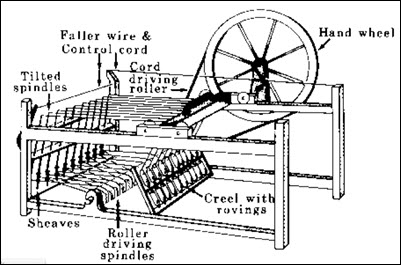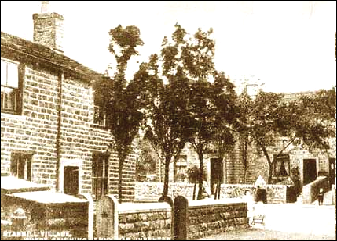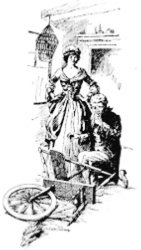


JAMES HARGREAVES c1720 -
xxxxxAs we have seen, in 1733 (G2) the English weaver John Kay greatly increased loom production by his invention of the flying shuttle. The first attempt to increase the production of yarn was made by the English spinner James Hargreaves. In 1764 he invented his "spinning jenny", and this hand-
 xxxxxAs we have seen, in 1733 (G2) the English weaver John Kay had greatly increased loom production by his invention of the flying shuttle. This, in turn, created a shortage of yarn and led to a number of attempts to increase its production. The first successful attempt was made by the English weaver and spinner James Hargreaves. In about the year 1764 he invented his "spinning jenny". This hand-
xxxxxAs we have seen, in 1733 (G2) the English weaver John Kay had greatly increased loom production by his invention of the flying shuttle. This, in turn, created a shortage of yarn and led to a number of attempts to increase its production. The first successful attempt was made by the English weaver and spinner James Hargreaves. In about the year 1764 he invented his "spinning jenny". This hand-
xxxxxHe used it successfully at his home at Stanhill, near Blackburn (illustrated), but once he began to sell the machine, alarm spread among those hand- competition would lose them their jobs, in 1768 a mob from Blackburn broke into his house and destroyed a number of the "jennies". He was forced to move to Nottingham where, in partnership with a slightly wealthier man named Thomas James, he established a small mill, and used the jennies to make quite a successful business.
competition would lose them their jobs, in 1768 a mob from Blackburn broke into his house and destroyed a number of the "jennies". He was forced to move to Nottingham where, in partnership with a slightly wealthier man named Thomas James, he established a small mill, and used the jennies to make quite a successful business.
xxxxxThe spinning jenny was but the first in a long line of improvements in the spinning process. As we shall see, in 1771 the English inventor and textile industrialist Richard Arkwright came up with his spinning frame, and in 1779  Samuel Crompton, combining the best features of the jenny and frame, produced his “spinning mule”. The movement known as the Industrial Revolution -
Samuel Crompton, combining the best features of the jenny and frame, produced his “spinning mule”. The movement known as the Industrial Revolution -
xxxxxIncidentally, it is generally accepted that Hargreaves' idea of a multiple spinning machine was due to his young daughter Jenny -
Acknowledgements
Spinning Jenny: date and artist unknown. Stanhill: contained in the Lancashire Evening Telegraph for use in the Cotton Town digitisation project, Blackburn with Darwen Borough Council – Blackburn Central Library with Darwen Museum and Art Gallery, Blackburn, Lancashire, England. Jenny: date and artist unknown.
G3a-


